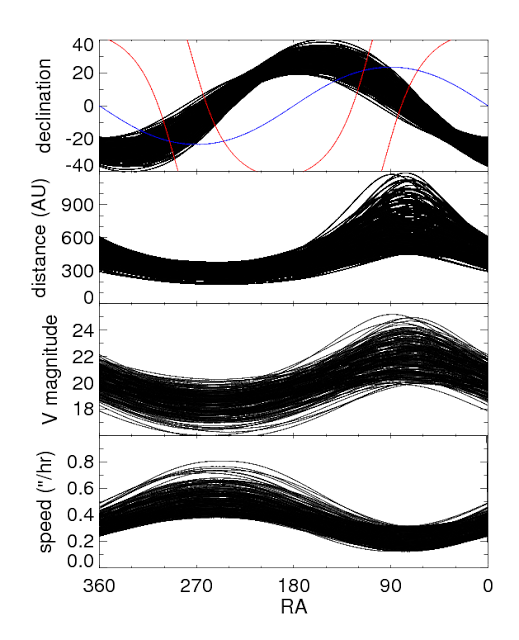It looks like you're using an Ad Blocker.
Please white-list or disable AboveTopSecret.com in your ad-blocking tool.
Thank you.
Some features of ATS will be disabled while you continue to use an ad-blocker.
share:
I had forgotten about the tilt of the planetary orbits with respect to the Sun's equator. That makes THREE theories that suggest the existence of a
large undiscovered planet in the outer Solar System.
originally posted by: Icarus Rising
I am skeptical. Not about the existence of Planet 9 (X, Niburu, whatever you want to call it), but Sheppard's statement that they don't know where it is. They should be able to calculate where it is given its influence on the solar system, shouldn't they?
Their calculations can determine its orbit (or a wide swath that could be its orbit), but not where it is along that orbital swath. If they find additional Kuiper Belt objects that (hypothetically) have been perturbed by Planet 9, they maybe they might be able to rule out certain parts of its orbit along which it currently might be and concentrate on other parts of its orbit. However, for the most part, right now they can only determine its orbit, but not its current position.
How they find planets, dwarf planets, asteroids, and comets is by taking a series of images of the sky and overlaying those images, searching for an object that might have moved differently against the background of stars.
Planet 9 is difficult to find because its calculated orbit takes it through the part of the sky (as seen from Earth's perspective) with the densest amount of background stars -- the Milky Way (the region of our sky that way look towards the center of our galaxy). Any movement of a planet (or dwarf planet, asteroid, or comet) moving against that very dense background of stars would be very difficult to detect because of all of the visual "noise" from those background stars. On top of that, Planet 9 would be very very dim relative to most of those stars and thus would be drowned out by them -- i.e., a picture might show Planet 9, but it might be right up against (or right on top of) a star and thus not be noticed.
Plus that part of its orbit (the part that takes it in front of the Milky Way background) is thought to be the part of its orbit that is farthest away from us, so the apparent movement of Planet 9 in these series of images will be very very tiny. Again, the density of the background of stars might render that tiny motion is undetectable, unless we get lucky enough to see it moving against a relatively blank part of the sky between two of those stars -- but their is very little relative relative blank sky to be seen in that portion of the sky.
The Search for Planet Nine
Excerpt:
The top plot shows our estimated orbital path. The red lines show the approximate outlines of the Milky Way galaxy, which we include in the plot as a warning: it is a lot harder to find objects when the bright Milky Way galaxy is in their background, as we witnessed with all of the difficulties that the New Horizons team had in finding Kuiper belt objects to go to after the Pluto flyby. If Planet Nine happens to be at one of these two places in its orbit it will, unfortunately, be much harder to find. The blue line shows the ecliptic -- the path of the planets across the sky -- which shows you than Planet Nine is tilted by about 30 degrees compared to the other planets of our solar system. The ~20 degree width of the estimated path of Planet Nine is largely due to the uncertainties in inclination and argument of perihelion.
edit on 2017-1-13 by Soylent Green Is People because: (no reason given)
Maybe the JWST will find Planet 9.
I guess we will keep finding dwarf planets
like vp113 until then.
I guess we will keep finding dwarf planets
like vp113 until then.
It wouldn't surprise me if there are also objects up to the size of Mars on highly elliptical orbits in the remote regions of the outer Solar System.
Based on the evidence that Earth was hit by one (which resulted in the formation of the Moon), and Mars itself was apparently hit by an object the
size of Pluto, I suspect that quite a few others may have been ejected from the inner Solar System after close encounters with Jupiter or
Saturn.
edit on 14-1-2017 by Mogget because: (no reason given)
NASA invites the public to help search for nearby worlds, including the possible Planet Nine:
www.nasa.gov...
What's interesting is that they use WISE imagery for this, so it seems that that infrared all-sky survey might yield something yet.
What's interesting is that they use WISE imagery for this, so it seems that that infrared all-sky survey might yield something yet.
new topics
-
Federal law trumps state and local law every time
Social Issues and Civil Unrest: 7 hours ago
top topics
-
Federal law trumps state and local law every time
Social Issues and Civil Unrest: 7 hours ago, 14 flags

